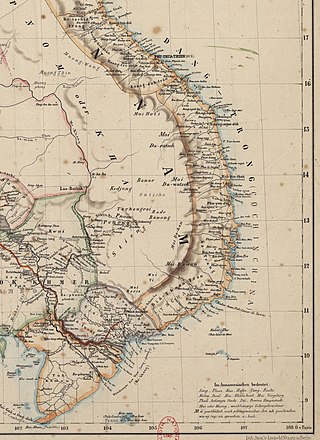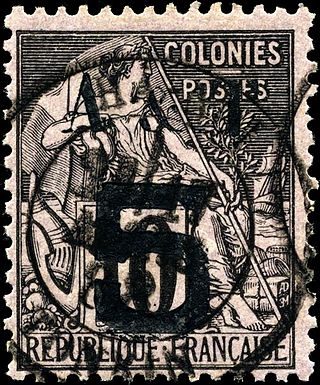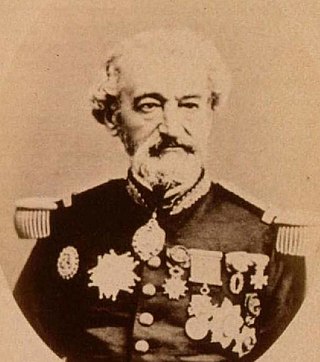
French Indochina, officially known as the Indochinese Union and after 1947 as the Indochinese Federation, was a grouping of French colonial territories in Southeast Asia until its demise in 1954. It comprised Cambodia, Laos, the Chinese territory of Guangzhouwan, and the Vietnamese regions of Tonkin in the north, Annam in the centre, and Cochinchina in the south. The capital for most of its history (1902–1945) was Hanoi; Saigon was the capital from 1887 to 1902 and again from 1945 to 1954.

Annam, or Trung Kỳ (中圻), was a French protectorate and colony encompassing the territory of the Empire of Đại Nam in Central Vietnam. Before the protectorate's establishment, the name Annam was used in the West to refer to Vietnam as a whole; Vietnamese people were referred to as Annamites. The protectorate of Annam became a part of French Indochina in 1887, along with two other Vietnamese regions, Cochinchina in the South and Tonkin in the North. The region had a dual system of French and Vietnamese administration. The government of the Nguyễn Dynasty still nominally ruled Annam and Tonkin as the Empire of Đại Nam, with the emperor residing in Huế. In 1948, the protectorate was merged in the Provisional Central Government of Vietnam, which was replaced the next year by the newly established State of Vietnam. The French legally maintained the protectorate until they formally signed over sovereignty to the Bảo Đại and the government of the State of Vietnam in 1950 after signing the Élysée Accords in 1949. The region was divided between communist North Vietnam and anti-communist South Vietnam under the terms of the Geneva Accord of 1954.

Cochinchina or Cochin-China is a historical exonym for part of Vietnam, depending on the contexts. Sometimes it referred to the whole of Vietnam, but it was commonly used to refer to the region south of the Gianh River.

Marie Joseph François Garnier was a French officer, inspector of Indigenous Affairs of Cochinchina and explorer. He eventually became mission leader of the Mekong Exploration Commission in 19th century Southeast Asia.

This is a survey of the postage stamps and postal history of Indochina.

Émile Gsell was a French photographer who worked in Southeast Asia, becoming the first commercial photographer based in Saigon. He participated in at least three scientific expeditions, and the images he produced from the first, to Angkor Wat, are among the earliest photographs of that site. Though he died at an early age, he managed to make several hundred photographs in just over a dozen years featuring a wide range of subject matter including architecture, landscapes, and studio, ethnographic and genre portraits.

French Cochinchina was a colony of French Indochina, encompassing the whole region of Lower Cochinchina or Southern Vietnam from 1862 to 1946. The French operated a plantation economy whose primary strategic product was rubber.

Nguyễn Phan Long served as Prime Minister of the State of Vietnam in January 1950. He was dismissed in May 1950 by the Emperor Bảo Đại under pressure from the French colonial authorities, who resented his pro-American and nationalist attitude.

The Treaty of Huế or Protectorate Treaty was concluded on 6 June 1884 between France and Đại Nam. It restated the main tenets of the punitive Harmand Treaty of 25 August 1883, but softened some of the harsher provisions of this treaty. The treaty, which formed the basis for the protectorates of Annam and Tonkin, and for French colonial rule in Vietnam during the next seven decades, was negotiated by Jules Patenôtre, France's minister to China, and is often known as the Patenôtre Treaty. The treaty was signed on the Vietnamese side by Phạm Thận Duật and Tôn Thất Phan, representatives of the emperor Tự Đức’s court. The treaty marked the Nguyễn dynasty's second acceptance of French protectorate in central and northern Vietnam, but it was canceled by the Nguyễn dynasty on 11 March 1945.
The assassination of Alfred François Bazin, a French labour recruiter in Hanoi, colonial Vietnam on February 9, 1929 marked the beginning of the demise of the Vietnamese Nationalist Party (VNQDĐ), which perpetrated the killing. The resulting French retribution severely weakened the fledgling Vietnamese revolutionary movement and hampered its ability to undermine colonial rule.

At the onset of World War I, Vietnam, nominally under the Nguyễn dynasty, was under French protectorate and part of French Indochina. While seeking to maximize the use of Indochina's natural resources and manpower to fight the war, France cracked down all Vietnamese patriotic movements. Many Vietnamese fought later in the conflict.

Auguste Jean-Marie Pavie was a French colonial civil servant, explorer and diplomat who was instrumental in establishing French control over Laos in the last two decades of the 19th century. After a long career in Cambodia and Cochinchina, Pavie became the first French vice-consul in Luang Prabang in 1886, eventually becoming the first Governor-General and plenipotentiary minister of the newly formed French colony of Laos.
French administration in Indochina began June 5, 1862, when the Treaty of Saigon ceded three provinces. By 1887 the French administered all of Indochina.

The Cochinchina campaign was a series of military operations between 1858 and 1862, launched by a joint naval expedition force on behalf of the French Empire and the Kingdom of Spain against the Nguyễn period Vietnamese state. It was the opening conflict of the French conquest of Vietnam.

The Tirailleurs indochinois were soldiers of several regiments of local ethnic Indochinese infantry organized as Tirailleurs by the French colonial authorities, initially in Vietnam from 15 March 1880. The most notable, and first established, of these units were the Tonkinese Rifles.
Asian diasporas in France consist of foreign residents and French citizens originating from Asian countries living in France. French citizens of Asian descent primarily have ancestry from the former French colonies of Indochina, as well as China or Turkey. Other Asian ethnic groups found in France include other West Asians, South Asians, Japanese, and Koreans.

The Mekong expedition of 1866–1868, conceived and promoted by a group of French colonial officers and launched under the leadership of captain Ernest Doudard de Lagrée, was a naval exploration and scientific expedition of the Mekong River on behalf of the French colonial authorities of Cochinchina. Its primary objective, besides scientific documentation, mapping, and the mission civilisatrice, was an assessment of the river's navigability in order to link the delta region and the port of Saigon with the riches of southern China and upper Siam. Ambitions were to turn Saigon into a successful commercial center such as British controlled Shanghai at the mouth of the Yangtze River.

Marie-Jules Dupré was a French admiral. He was governor of Réunion from 1865 to 1869 under the Second French Empire, and governor of Cochinchina from 1871 to 1874 under the French Third Republic. He negotiated a treaty with the Emperor of Vietnam that opened up the country to French commerce and ceded territory in the south to France.
The Treaty of Saigon was signed on 15 March 1874 by the Third French Republic and the Nguyễn dynasty of Vietnam. Vietnam made economic and territorial concessions to France, while France waived a previous war indemnity and promised military protection against China. The treaty effectively made Vietnam a protectorate of France.

The French conquest of Vietnam (1858–1885) was a long and limited war fought between the Second French Empire, later the French Third Republic and the Vietnamese empire of Đại Nam in the mid-late 19th century. Its end and results were victories for the French as they defeated the Vietnamese and their Chinese allies in 1885, the incorporation of Vietnam, Laos, and Cambodia, and finally established French rules over constituent territories of French Indochina over Mainland Southeast Asia in 1887.














